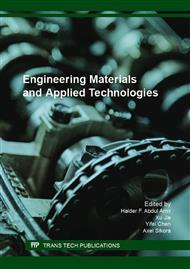p.3
p.9
p.14
p.20
p.25
p.30
p.37
p.42
Effects of Drying Techniques on the Crystallinity and Thermal Properties of Empty Fruit Bunch Nanocrystalline Cellulose
Abstract:
The effect of drying techniques on the crystallinity and thermal stability nanocrystalline cellulose (NCC) prepared from oil palm empty fruit bunch (OPEFB) via the TEMPO-oxidation process was investigated. NCC was subjected to three separate drying techniques viz. oven drying (OD), freeze drying (FD) and solvent exchange (SE). The crystallinity and thermal properties were investigated for all samples using DSC and X-ray diffraction (XRD). There is no significant difference in the degree of crystallinity for both OD-NCC and FD-NCC as compared to the starting material of unbleached pulp (UP) (72% vs 76%), however SE-NCC showed a tremendous reduction with the crystallinity of only 40%. Both OD-NCC and FD-NCC have almost similar thermal behavior but the SE-NCC showed a significant difference. For the application of NCC in non-polar bionanocomposites, both OD-NCC and FD-NCC is recommended due to its relatively superior thermal stability and a higher crystallinity index.
Info:
Periodical:
Pages:
20-24
Citation:
Online since:
September 2016
Authors:
Price:
Сopyright:
© 2016 Trans Tech Publications Ltd. All Rights Reserved
Share:
Citation:


